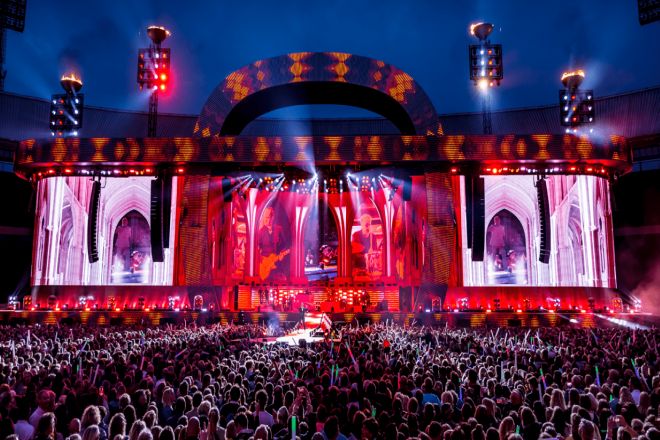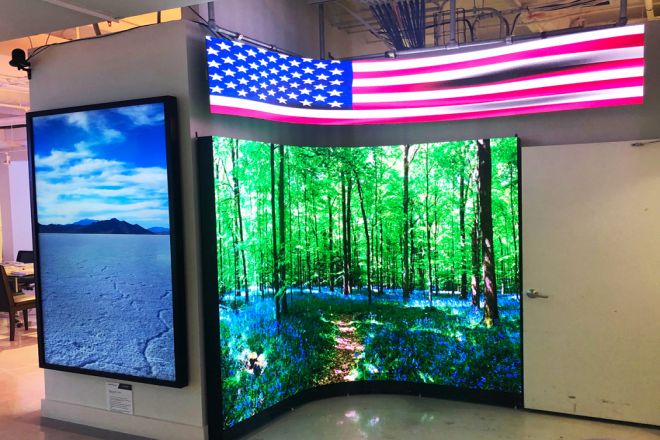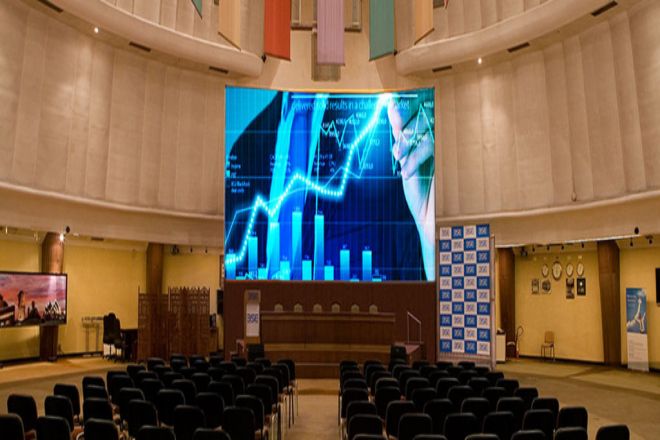序章

LED表示画面 have been widely used in modern event sites due to their high brightness, high definition, long life, and flexible characteristics. Whether indoors or outdoors, choosing the right LED display screen is crucial to improving the effect of the event. This article will explore how to choose a suitable LED display screen from the perspective of different event sites.
1. Clarify the type of event site
When choosing an LED display screen, the first task is to clarify the type of event site because different types of sites have completely different requirements for display screens. The following is a detailed analysis of indoor and outdoor event sites:
1). Indoor event site
1.1). 政府, government agencies, and institutions:
Application scenarios: video conferencing, monitoring centers, command centers, studios, etc.
Demand characteristics: These places have extremely high requirements for the clarity and fineness of the picture to ensure accurate information transmission.
Recommended models: Small-pitch LED displays such as P0.8, P0.9, and P1.0 are often used. These displays have a small pixel pitch, which can achieve ultra-high clarity and resolution, ensuring that the picture is delicate and grainy.
1.2). Meeting rooms, lecture halls, 展示 ホール:
Application scenarios: daily meetings, report presentations, product exhibitions, etc.
Demand characteristics: The audience is usually at a distance of 3 meters, and the display screen needs to maintain good visual effects over a large area.
Recommended models: P2, P2.5, P3, and other indoor high-definition LED display screens are more suitable. These models not only ensure clarity, but also take cost-effectiveness into consideration, and are suitable for large-area installation.
1.3). ホテル banquet halls restaurant stage backgrounds:
Application scenarios: banquets, performances, celebrations, etc.
Demand characteristics: The display screen needs to be light and easy to carry, easy to install and disassemble quickly, and can be freely spliced according to the venue environment.
Recommended models: P4, P5, and other models are more common. These display screens not only have good display effects but also have high flexibility and portability.
2). アウトドア event sites
2.1). Billboards
Application scenarios: outdoor advertising displays.
Demand characteristics: It needs to have high brightness to cope with direct sunlight, and it needs to have a high protection level to withstand bad weather (such as wind, rain, lightning, etc.).
Recommended models: P10, and other models are more common. These displays are not only bright but also have a high level of protection, which can ensure stable operation in outdoor environments.
2.2). Large event sites:
Application scenarios: concerts, sports events, celebrations, etc.
Demand characteristics: large-area, high-definition LED displays are required to provide stunning visual effects and a wide viewing angle.
Selection points: When choosing, in addition to considering the brightness and clarity of the display, you also need to consider its size, installation convenience, and convenience of later maintenance. Usually, such activities will use special large-size, high-brightness LED displays, which will be installed and debugged by a professional team.
2. Consider key factors

When choosing an LED display, in addition to clarifying the type of event site, you also need to consider the following key factors to ensure that the display can perfectly adapt to various needs.
1). 視聴距離
1.1). Close viewing:
Scene examples: government meetings, studios, conference rooms, etc.
Selection points:
In these scenes, the audience is close to the display, so you need to choose a high-resolution, high-definition LED display. High resolution can ensure clear picture details, and high definition can enhance the visual experience, allowing the audience to feel the delicacy and reality of the picture at close range.
1.2). Long-distance viewing:
Scene examples: outdoor billboards, large-scale event sites, etc.
Selection points:
In these scenarios, the audience is far away from the display, so special attention needs to be paid to pixel size and brightness.
A larger pixel size can maintain the clarity of the picture at a long distance, while high brightness can ensure that it can still be displayed clearly in strong light environments, such as direct sunlight, and not be overwhelmed by ambient light.
2). 輝度 と色
2.1) 屋内LEDディスプレイ:
Brightness range: Generally controlled at around 800-2000cd to avoid excessive brightness causing visual discomfort to the audience.
Color requirements: The colors need to be bright and highly saturated to ensure that the picture is rich and vivid and enhance the audience’s viewing experience.
2.2) 屋外用LEDディスプレイ:
Brightness requirements: It needs to reach 2000-6000cd to cope with the complex outdoor light environment and ensure that it can still be displayed clearly under direct sunlight.
Color requirements: High contrast and vividness are required to maintain color accuracy and clarity under strong light and avoid color distortion or blur.
3). Cost Control
Budget considerations: Choose the appropriate LED display model and specifications according to the activity budget to ensure the best display effect within limited funds.
Long-term costs: In addition to the purchase cost, the later maintenance cost of the display needs to be considered, including energy consumption, repair costs, etc. Choosing a display with high energy efficiency and low maintenance costs will help reduce long-term operating costs.
4). Flexibility and portability
- Scenario requirements:
For activities that require frequent venue changes or temporary construction (such as exhibitions, celebrations, etc.), it is particularly important to choose LED displays that are easy to carry, transport, and disassemble.
These displays are usually designed with lightweight frames and quick installation systems, which can complete the construction and disassembly work in a short time, improving the efficiency of the event.
- モジュール設計:
Consider choosing a modularly designed LED display, which allows users to freely combine and splice display units according to actual needs to adapt to venues of different sizes and shapes. At the same time, modular design also helps to reduce transportation and storage costs and improve the flexibility and practicality of the display.
3. Choose the right type of LED display
Generally, when holding an event, people like to use rental LED display screens. Rental LED screens are designed for stage performances, literary and artistic activities, etc. They have the characteristics of repeated disassembly and installation, ultra-light and ultra-thin, space-saving, and splicing in any direction and size.
They usually use SMD surface mount three-in-one packaging technology, which can achieve ultra-wide viewing angles to meet different needs.
However, there are many common types of rental LED screens. How to choose?
P5, P6, P10, and other specifications, with high transparency, are suitable for scenes that require transparent or translucent display effects, such as glass curtain walls, stage backgrounds, etc.
- Rental LED full-color screens:
Including P4, P5, P6, and other specifications, can display rich colors and delicate pictures. It is the most common type in the rental market and is suitable for various indoor and outdoor performances and event sites.
It is composed of flexible soft modules or realized by rotating splicing of conventional modules. It is suitable for scenes that require curved display effects, such as LED cylindrical screens, spherical LED screens, etc. It has a unique shape and strong rendering power. It is suitable for large-scale events and exhibitions that require unique visual effects.
4. Consider other factors

When choosing an LED display, in addition to the key factors mentioned above, there are some other factors that are also worth paying attention to, which have an important impact on the performance and user experience of the display.
1). 視野角
The viewing angle refers to the angle range at which the audience can clearly see the image when viewing the display from all directions. A wide viewing angle ensures that no matter where the audience is, they can get a good visual effect.
Selection suggestions:
- Indoor display:
Although the viewing angle requirements for indoor environments are relatively low, in order to ensure that all participants or audiences can clearly see the screen content, it is recommended to choose a display with at least 120° horizontal viewing angle and 90° vertical viewing angle.
- Outdoor display:
Since outdoor audiences may come from all directions, it is more necessary to choose an LED display with a wide viewing angle. Some high-end outdoor displays can even reach a horizontal viewing angle of more than 160°, ensuring that the audience can get a clear image at different angles.
2). Protection level
The protection level is an important indicator to measure the protection capabilities of the display such as dust and water resistance. For outdoor displays, a higher protection level can ensure that they can still work stably in bad weather.
Selection suggestions:
- Indoor display screen:
Although the indoor environment is relatively good, a certain level of protection still needs to be considered to prevent dust, water mist, etc., from affecting the display screen. Generally, the protection level of indoor display screens can reach IP20 or higher to meet basic needs.
- Outdoor display screen:
Outdoor display screens need to have a higher level of protection, and it is generally recommended to reach at least IP65. This means that the display screen can completely prevent dust from entering and can prevent water from entering under certain water pressure, thereby effectively resisting severe weather such as wind, rain, and lightning.
3). Control method
The control method determines the content and method of the display screen, which is crucial to meet the display needs in different scenarios.
Selection suggestions:
- 同期制御:
Suitable for scenarios where dynamic content such as videos and images need to be played in real time. Through the synchronous control system, the display screen can be connected to computers, video players, and other devices in real time to ensure the synchronous update and display of the content.
- Wireless control:
With the development of wireless technology, wireless control methods have gradually become a trend. Through a wireless network connection, the display screen can be remotely controlled and updated, which improves the convenience and flexibility of use.
However, it should be noted that wireless control may be limited by signal interference and transmission distance, so it is necessary to consider carefully when choosing.
結論
Choosing a suitable LED display screen is crucial to improving the effect of the event site. In the selection process, it is necessary to clarify the type of event site, consider factors such as viewing distance, brightness and color, cost control, and flexible portability, and select the appropriate type of LED display screen based on actual needs.
At the same time, it is also necessary to pay attention to details such as the viewing angle, protection level, and control method of the display screen to ensure that the final selected LED display screen can meet the needs of the event site.
最後に、LEDディスプレイスクリーンについてさらに詳しく知りたい場合は、 ご連絡ください。
